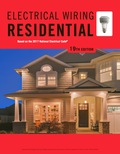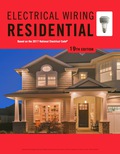
EBK ELECTRICAL WIRING RESIDENTIAL
19th Edition
ISBN: 9781337516549
Author: Simmons
Publisher: CENGAGE LEARNING - CONSIGNMENT
expand_more
expand_more
format_list_bulleted
Concept explainers
Question
Chapter 2.1, Problem 8R
To determine
Explain the term notation.
Expert Solution & Answer
Want to see the full answer?
Check out a sample textbook solution
Students have asked these similar questions
Find the Thevenin Equivalent of the circuit below, show all steps;
Find the Thevenin Equivalent Circuit of the following and find the current through R_L, show all steps;
Find the Thevenin Equivalent Circuit of the circuit below and the current through R_L , show all steps;
Chapter 2 Solutions
EBK ELECTRICAL WIRING RESIDENTIAL
Ch. 2.1 - What is the purpose of specifications?Ch. 2.1 - Refer to the specifications in the back of this...Ch. 2.1 - What is done to prevent a plan from becoming...Ch. 2.1 - Name three requirements contained in the...Ch. 2.1 - Prob. 5RCh. 2.1 - What phrase is used when a substitution is...Ch. 2.1 - What is the purpose of an electrical symbol?...Ch. 2.1 - Prob. 8RCh. 2.1 - Prob. 9RCh. 2.1 - What three parties must be satisfied with the...
Ch. 2.1 - What does a plan show about electrical outlets?...Ch. 2.1 - Prob. 13RCh. 2.1 - Prob. 14RCh. 2.1 - Prob. 15RCh. 2.1 - Prob. 16RCh. 2.1 - Prob. 17RCh. 2.1 - Prob. 18RCh. 2.1 - Prob. 19RCh. 2.1 - What methods may be used to mount luminaries to an...Ch. 2.1 - What advantage does a 4 in. octagon box have over...Ch. 2.1 - What is the size of the opening of a switch...Ch. 2.1 - Prob. 23RCh. 2.1 - Prob. 24RCh. 2.1 - Prob. 25RCh. 2.1 - Prob. 26RCh. 2.1 - Prob. 27RCh. 2.1 - Prob. 28RCh. 2.1 - Prob. 29RCh. 2.1 - Prob. 30RCh. 2.1 - Prob. 31RCh. 2.1 - Prob. 32RCh. 2.1 - Prob. 33RCh. 2.1 - Prob. 35RCh. 2.1 - Prob. 37RCh. 2.1 - Prob. 38RCh. 2.1 - Prob. 39RCh. 2.1 - Prob. 40RCh. 2.1 - Prob. 42RCh. 2.1 - Does the NEC allow metal raceways to be used with...Ch. 2.2 - Prob. 1RCh. 2.2 - What is the size of the footing for the steel...Ch. 2.2 - Prob. 3RCh. 2.2 - Prob. 4RCh. 2.2 - Prob. 5RCh. 2.2 - Prob. 6RCh. 2.2 - How far is the front garage wall from the curb?...Ch. 2.2 - How far is the side garage wall from the property...Ch. 2.2 - Prob. 9RCh. 2.2 - What is the purpose of the I-beams that rest on...Ch. 2.2 - Where is access to the attic provided?...Ch. 2.2 - Prob. 13RCh. 2.2 - Prob. 14RCh. 2.2 - Prob. 15RCh. 2.2 - Prob. 16RCh. 2.2 - What is the stud size for the partitions between...Ch. 2.2 - Who is to furnish the range hood?...Ch. 2.2 - Who is to install the range hood?...
Knowledge Booster
Learn more about
Need a deep-dive on the concept behind this application? Look no further. Learn more about this topic, electrical-engineering and related others by exploring similar questions and additional content below.Similar questions
- Find the Norton Equivalent of the below and the voltage across R_L, show all steps;arrow_forwardUse Mesh Analysis to find the current through the laod resistor R_L. Show all steps;arrow_forwardFind Thevenin Equivalent of the circuit below and the current through the load resistor R_L. Show all steps;arrow_forward
- If = 5000 A actual time IDMT ---R,, Reand R3 The Tsm relays R, and R3 Draw The characteistic relays time margin between Tsm = 0.5 RCT=500/1 CS-125% TSM = 2 TSM = 0.2 and -0.6 R2 CTS = 500/1 Cs=100% Tsm=0.4 R3 CTS = 400/1 Cs=125% TSM = 2arrow_forwardLet X and Y be random variables having joint density function 01.5). (c) p(x) and p(y).arrow_forwardThe joint density function of two continuous random variables X and Y is: p(x, y) = {cxy 0 < x < 4,1 < y < 5 0 otherwise Find (i) the constant c (ii)P(1arrow_forwardBelow is a rough schematic of the lighting system for a streetcar powered by a 120 VDC supply. How can I arrange the wires inside the trolley for the interior lights (1-16), headlights (19-20), doors (21-24), and platform lights (17-18), ensuring that each has its own switch? Does the electrical system require additional safety components? What type of cable can be used for wiring these lights?arrow_forward12.8 Obtain the inverse Laplace transform of each of the fol- lowing functions by first applying the partial-fraction-expansion method. (a) Fi(s) 6 = (s+2)(s+4) (b) F2(s) = (c) F3(s) = 4 (s+1)(s+2)2 3s3 +36s2+131s+144 s(s+4)(s²+6s+9) 2s²+4s-10 (d) F4(s) = (s+6)(s+2)²arrow_forward12.4 Determine the Laplace transform of each of the followingfunctions by applying the properties given in the Tables (a) f1(t) = 4te−2t u(t)(b) f2(t) = 10cos(12t +60◦) u(t)*(c) f3(t) = 12e−3(t−4) u(t −4)(d) f4(t) = 30(e−3t +e3t ) u(t)(e) f5(t) = 16e−2t cos4t u(t)(f) f6(t) = 20te−2t sin4t u(t)arrow_forward8. Obtain the inverse Laplace transform of each of the followingfunctions by first applying the partial-fraction-expansionmethod.(a) F1(s) =6(s+2)(s+4)(b) F2(s) =4(s+1)(s+2)2(c) F3(s) =3s3 +36s2 +131s+144s(s+4)(s2 +6s+9)(d) F4(s) =2s2 +4s−10(s+6)(s+2)2arrow_forward12.12 In the circuit of Fig. P12.12(a), is(t) is given by the waveform shown in Fig. P12.12(b). Determine iL (t) for t≥ 0, given that R₁ = R₂ = 2 2 and L = 4 H. is() R₁ R2: (a) Circuit is(t) 8A- 8e-21 elle (b) is(t) Figure P12.12 Circuit and waveform for Problem 12.12. iLarrow_forward12.12 In the circuit of Fig. P12.12(a), is(t) is given by thewaveform shown in Fig. P12.12(b). Determine iL(t) for t ≥ 0,given that R1 = R2 = 2 W and L = 4 H.arrow_forwardarrow_back_iosSEE MORE QUESTIONSarrow_forward_ios
Recommended textbooks for you
 EBK ELECTRICAL WIRING RESIDENTIALElectrical EngineeringISBN:9781337516549Author:SimmonsPublisher:CENGAGE LEARNING - CONSIGNMENT
EBK ELECTRICAL WIRING RESIDENTIALElectrical EngineeringISBN:9781337516549Author:SimmonsPublisher:CENGAGE LEARNING - CONSIGNMENT

EBK ELECTRICAL WIRING RESIDENTIAL
Electrical Engineering
ISBN:9781337516549
Author:Simmons
Publisher:CENGAGE LEARNING - CONSIGNMENT
Types of House Wiring - Types of Electrical Wiring - Electrical Wiring; Author: Learning Engineering;https://www.youtube.com/watch?v=A5P-buWX-dA;License: Standard Youtube License